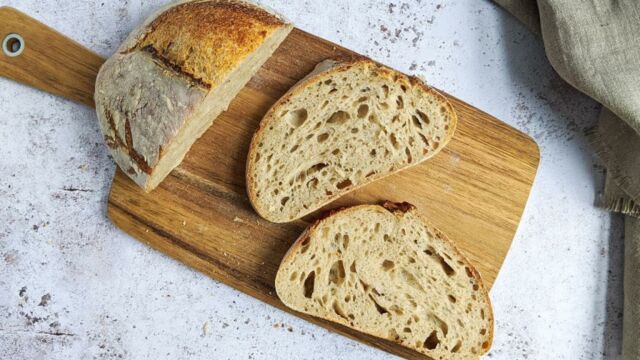Bread has a glycemic index, which estimates the effect of a food on your blood sugar level. The glycemic index in bread varies depending on whether the bread is fresh, frozen, or stale. So which is healthiest?
Discover our latest podcast
Fresh bread
The biggest health advantage of fresh bread is its high moisture content. Dietitian Dr Sarah Schenker said:
White flour is fortified with iron and calcium as well as two B vitamins, niacin and thiamin — which are water soluble. The higher moisture content enhances their absorption.
Schenker says fresh bread is a helpful source of pre-exercise energy due to its higher glycaemic index—meaning it is converted into sugar in the blood more quickly, providing energy for exercise.
Fresh bread is also easier to digest for people who might suffer from bloating and gas, as it has lower levels of resistant starch.
Try to avoid white, sliced, mass-produced loaves and get a natural fresh loaf from your local baker for a more nutritious option.

Frozen and toasted bread
According to a 2008 study by Oxford Brookes University, both freezing and toasting bread reduces the glycaemic response of bread (the speed at which the starches break down to sugars). Freezing and toasting bread changes the make-up of starch molecules, making them more resistant to digestion.
The study found that toasted fresh bread produced a 25% lower blood sugar response than fresh bread, but toasted frozen bread puts the molecules through an extra distortion process, lowering that response by almost 40%.
This is a positive—the more ‘resistant’ starch, the more slowly it is digested by the body, resulting in a more gradual release of glucose into the bloodstream. This means it is less likely to cause an insulin and blood sugar spike, potentially reducing the risk of type 2 diabetes.
Just be careful not to burn it because burnt toast contains acrylamide, and high amounts of acrylamide may increase your risk of cancer.
Stale bread
Stale bread may not be very tasty but it might be a healthy option—potentially even reducing the risk of bowel cancer.
Researchers at Australia’s Royal Melbourne Institute of Technology conducted a study in 2017 where they baked white bread and let it sit at various temperatures for up to a week.
When they tested the samples, they found the stale crumbs had higher levels of resistant starch than fresh bread.
The researchers said that when gut bacteria feed off these starches, they convert them to fatty acids, which protect against bowel cancer. These fatty acids also stimulate hormones that send signals to the brain that we are full.
Read more:
⋙ A Baker Reveals the Awful Ingredients of Industrial White Bread















